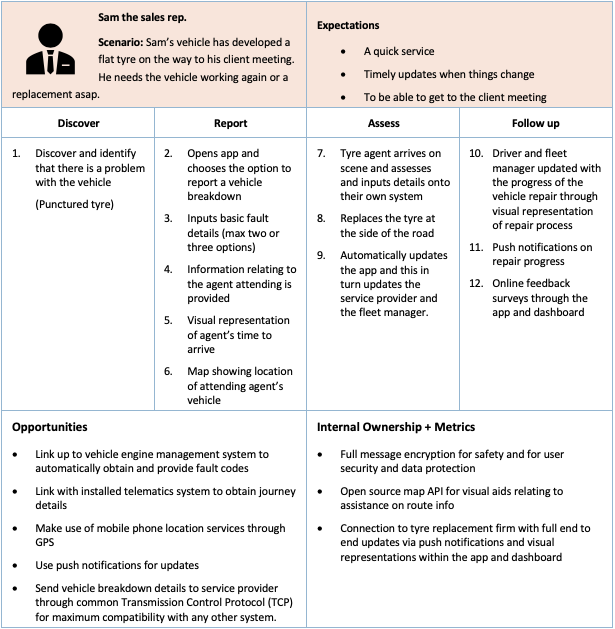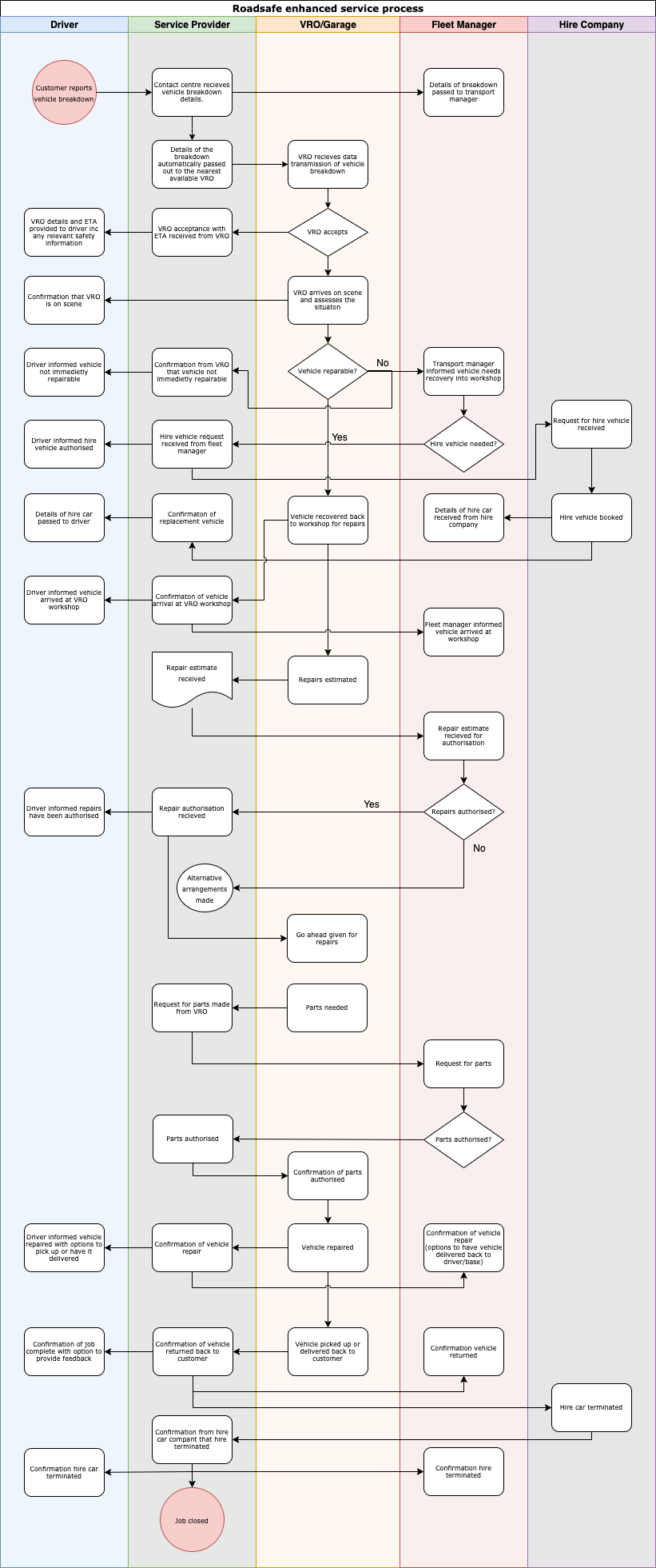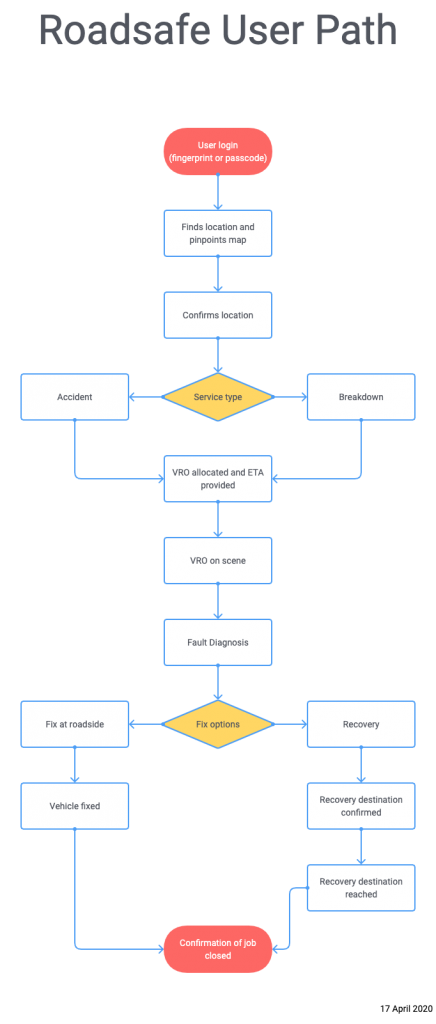Roadsafe
Roadside Assistance and Recovery App
Project Scope
Description
Breakdown assistance is a big undertaking which involves a large network of people at all stages of the process, from handling the initial telephone call into a contact centre. Be it a government agency emergency contact centre or a private insurance claims call centre, to the individual who is eventually sent out to assist the road user.
This whole end to end process can take time and can be prone to delays at each stage. The most common bottleneck being at the very start where a driver sits waiting on a call to be connected.
There’s nothing worse than being stuck on the side of a busy road with traffic hurtling by whilst trying to communicate to someone on the phone and pass on key bits of information with all the background noise in an unsafe environment.
Smartphones in their popularity with nearly every driver in the possession of one pose a solution to this problem with the inclusion of location-based services and a very good mobile internet coverage these days.
The idea of being able to report a vehicle breakdown or an accident almost instantly through the use of a smartphone application, straight to the network providers or first responders, whilst not a new concept. Is most definitely going to shake up the existing roadside assistance market.
Introduction
Roadsafe app is a vehicle breakdown and accident reporting tool that consists of a mobile phone application for the drivers and a website dashboard for fleet managers.
It notifies the vehicle breakdown or accident management service provider of an incident once the driver reports it through the app.
Once the incidents are reported, the dashboard sends automated notifications to the fleet manager and service provider. Once a vehicle recovery operator (VRO) has been allocated an automated notification is sent to both eh driver and the fleet manager.
The app displays the driver and the vehicle details as well as any important service level agreements and information relating to things that the driver’s breakdown cover provides such as, for example, a hire car. It contains a map of the driver’s current location when applicable and will also display information relating to the ETA of any assistance in visual form.
The fleet managers dashboard has information relating to the entire fleet with details of ongoing incidents and vehicles being repaired in the workshop. This is all displayed in visual form with a timeline showing the progress of repairs.
The app and dashboard will be deemed successful if we see a significant decrease response times for roadside incidents and also in questions about the progress of incidents from the fleet managers, as well as a significant decline in delays for repair authorisations due to instant online tracking and updates.
Benefits
The solution will be a platform that consists of:
- A smartphone application at the driver’s end
- A dashboard at the transport managers end if applicable
- A home dashboard if it is for an individual or family account.
Objectives
The idea is that the driver can use their mobile phone to connect with the vehicle breakdown assistance or accident management provider much quicker and possibly safer than through the traditional method of making a phone call. The driver may not need to provide information such as location or direction of travel as the location-based service will already hold this important info.
Goals
This could reduce the time wasted in passing on information down from anywhere between 10 – 45 mins, to just a matter of a minute or two. The time saved on the initial call could, in turn, reduce the overall wait time for roadside assistance.
Purpose
The solution could be a standalone platform, or it could form part of an existing system such as a fleet management or a breakdown assistance service.
It will, therefore, be a web-based service, hosted in the cloud and accessed through the smartphone app and the dashboard on desktops or tablets.
It will connect to the service provider through some type of Transmission Control Protocol (TCP).
The service provider will continue to connect to their network of engineers and recovery operators as the solution will not currently cover communications at that end. This will continue to be done through services such as the widely used Turbo Dispatch.
Features
The new system must include the following:
- The ability for the end-user to use on their own or company smartphone
- Ability to report a vehicle breakdown or accident quickly and efficiently
- Ability to interface with existing data warehouse and web services
- Ability to incorporate automated routing and notifications based on business rules
- Ability to track the driver using location-based services (GPS) through a smartphone
- Provide updates to the end-users (Drivers and transport/fleet managers)
- Interface with existing telematics and fleet management software.
User Overview
User Personas


User Empathy Map
Empathy-Map-Canvas-006b-copyCustomer Journey Map
CUSTOMER-JOURNEY-MAP-V2What do the users want?
- To be able to have some assistance with them as quickly as possible
- To have their problem resolved quickly.
- To have a good user experience.
- To be kept up to date throughout the whole process.
How?
- To be able to reach the service provider quickly and to have the related information passed across to them quickly.
- The service provider to have all of the correct info to be able to fix the problem.
- By using a system that is user friendly and reliable.
- With up to date visual representation of the current progress of the repair process.
Operating Environment
The app (Roadsafe) will work on the user’s mobile smartphone device with operating systems consisting of either Android, IOS or Windows.
It will communicate with the service provider through the use of an Application Programming Interface (API) and possibly Remote Procedure Calls (RPC) through some form of Internet Transfer Protocol (TCP/IP).
The service provider will sit in the middle and then communicate with whichever network of providers they employ through the use of the commonly used Turbo Dispatch system or the more modern software as a service platforms used in the transport industry such as 1link.
The diagram below illustrates the full end to end process.

Defining the solution
Deliverables
- A smartphone app for both Android and IOS devices
- Reporting vehicle breakdowns and accidents
- Tracking client vehicle and recovery agent for accurate timings via location-based services and GPS
- Uses push notifications for updates
- A website for desktop and tablet devices that functions as a dashboard and management console
- Connection/Interface to allow use with existing platforms and service providers for quick digital transfer of messages and information.
Pages/Screens with Features


Implementation Plan

Technology to be used
For the wireframes and the Prototype
Adobe XD for rapid prototype development and sharing with stakeholders.
For the mobile app
In order to allow rapid development for both the Android and IOS platforms at once a development environment and UI toolkit will be used such as one of the following:
- Googles Flutter which uses the DART programming language to create native apps.
- Adobe PhoneGap which uses Apache Cordova to create mobile apps using HTML, CSS and JavaScript
- React Native which is Facebooks mobile application framework